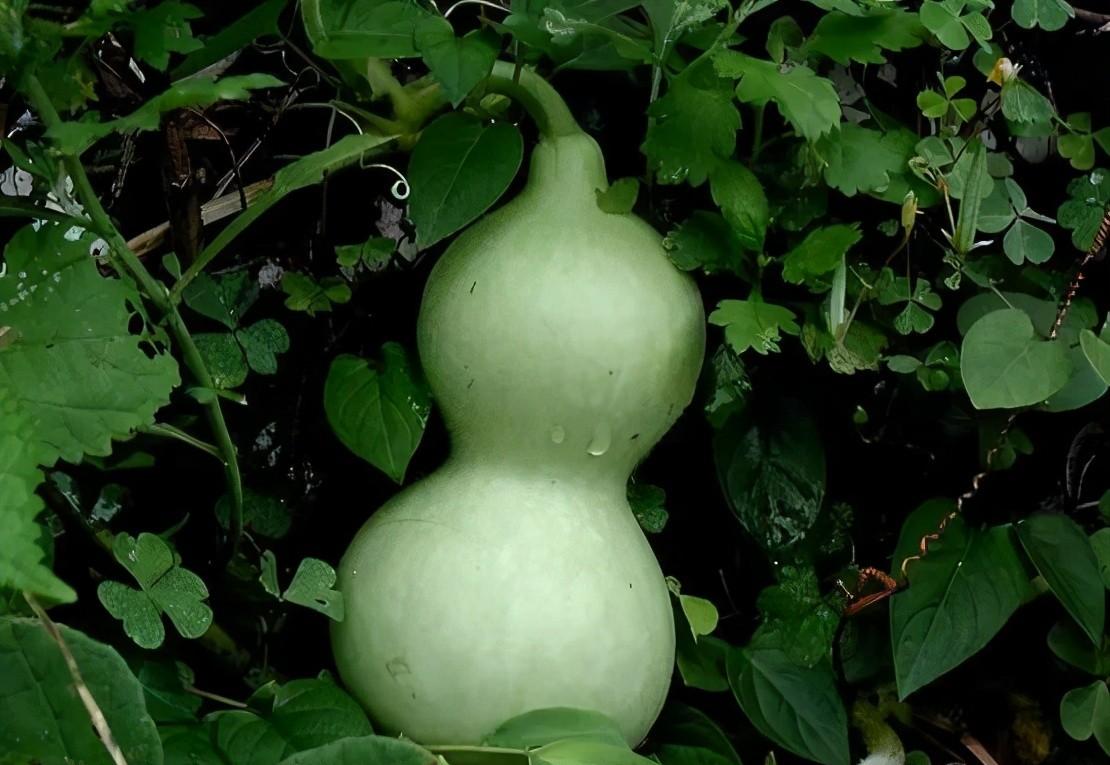What were the first plants domesticated by humans? The answer is not the familiar crops of wheat, rice, and corn, but the Lagenaria siceraria, which is less frequent in our daily lives.
Gourds belong to the gourd family, and belong to the same family as watermelons, cucumbers and other melons. Although the young gourd is now also used as a small amount of food, the earliest domestication of the gourd by humans did not look at its edibleness. The outer wall of the mature gourd is lignified, impermeable and corrosion-resistant, and is a very good container — either as a kettle in its entirety, or as a two-petal scoop, or with both ends open for use as a water pipe, and when dealing with water, it is rare to encounter such a convenient and inexpensive material.

Unripe gourd fruit. Image: Wiki commons
Like many other melons, gourds are a vine. Under ideal conditions, their vines can grow to 7 to 10 meters long, and if planted under a tree, they can climb effortlessly to the top of the canopy for better light conditions. But in production life, people will cut off their top buds early, forcing the gourd vine to produce more branches, thus opening more flowers and producing more gourds.
The flowers of the gourd are divided into male and female, although they look like white ones, but the male flowers have obvious stamens and pollen, while the female flowers have a clearly visible lower sub-room - simply put, there is a small gourd under the flower. The gourd mainly relies on bees to pollinate, and if it is not pollinated in time, the female flowers will fall along with the "small gourd". Therefore, in cities with few bees, it is often necessary to artificially pollinate to ensure that the flowers are conceived.
The flowers of the gourd. Image: Wiki commons
Native to southern Africa, the gourd is still home to wild gourd populations in Zimbabwe. Wild gourds have thinner walls and are not strong enough to be used as water storage containers, while their domesticated relatives have exploded their ancestors in terms of water storage capacity, both in terms of firmness and waterproofness, which shows that early humans screened gourds according to these conditions.
Gourds were first domesticated in Africa, but according to some archaeological sources, there were at least two separate domestication processes — one in Asia 8,000 years ago and once in Egypt 4,000 years ago. In any case, this vine followed humans out of Africa and spread to every corner of the eurasian continent in the tropics and subtropics. Surprisingly, before Columbus reached the Americas, the gourd had already taken root in the Americas. Some scholars believe that the gourds of the Americas are more closely related to the gourds of Asia, because the ancestors of the Indians brought them from Asia through the frozen Bering Strait; others, based on more detailed molecular biological evidence, believe that the gourds of the Americas may have come directly from wild species in Africa, and that their seeds drifted all the way from the sea to the Americas, possibly ten thousand years ago or even earlier.
The shape of the gourd is very diverse, not only the upper and lower ones. Image: Wiki commons
In traditional Chinese culture, gourds also occupy an important place. It is often associated with health – in traditional medicine, gourds are used to hold various drugs, and there is a saying that "hanging pots are in the world". Of course, the gourd can not only contain medicine that does not know what it is, but also often wine, vinegar, or other liquids. Speaking of "painting scoops according to gourds", we can also see the close relationship between scoops and gourds. In addition, the gourd is often processed into a cage containing crickets and other song bugs, and in addition to being convenient and easy to obtain, it can also amplify the sound of insects like the resonance box of musical instruments.
Hand-polished gourd. Image: lywww.com
It is only with the advancement of modern material technology that the gourd, as a container, is becoming more and more dispensable. Even as a kind of literary play, it is increasingly undervalued in the face of various expensive new materials. Little by little, this crop, which humans domesticated, fades away from us—leaving only a few words or a symbol reminding us that it was once there.